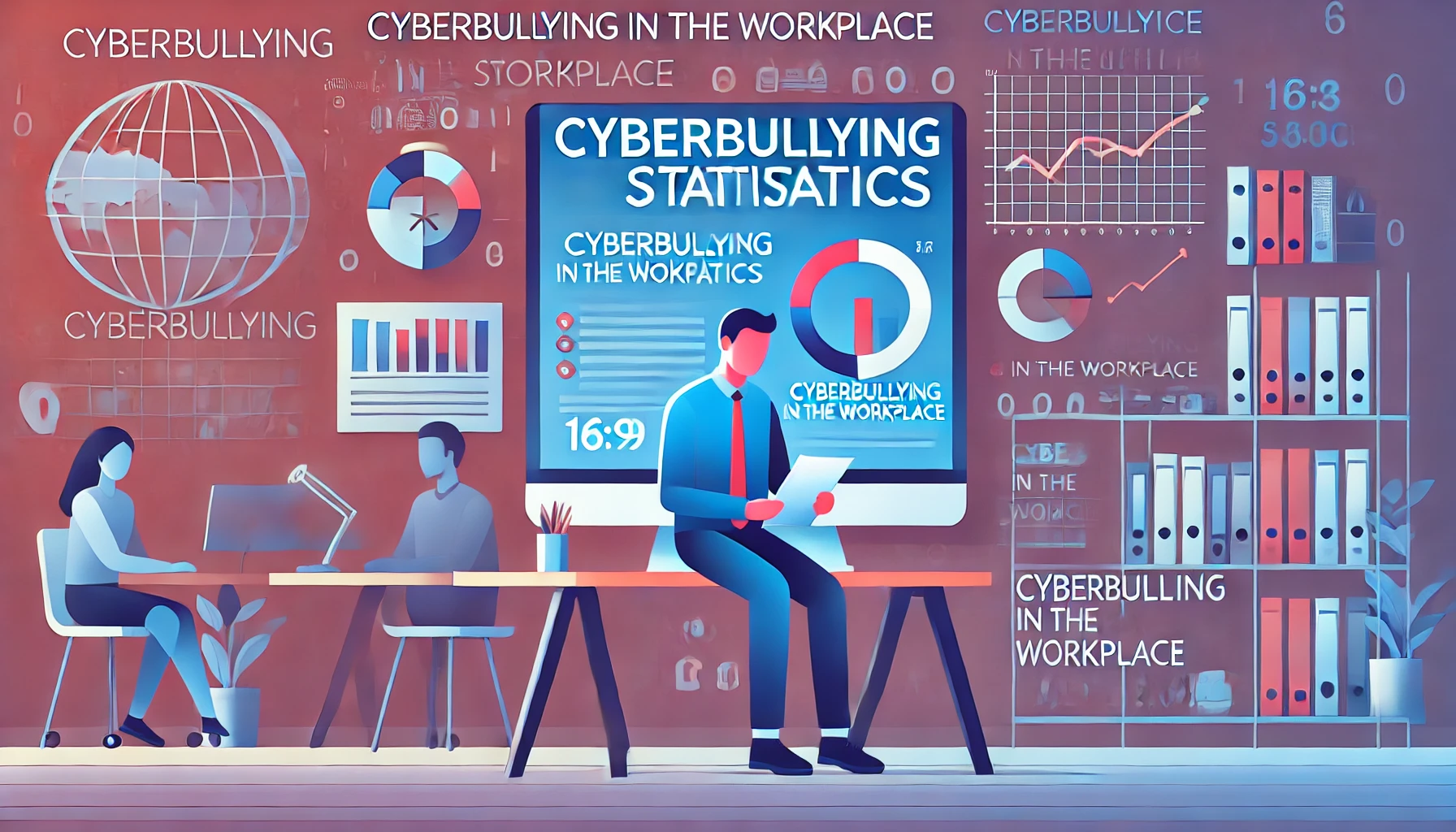Cyberbullying In The Workplace Statistics 2024
Updated · Jul 02, 2024

WHAT WE HAVE ON THIS PAGE
Introduction
Cyberbullying In The Workplace Statistics: Workplace cyberbullying has a dangerous social, behavioural, and psychological effect on companies and employees. As per the survey, workplace cyberbullying decreases with growing social capital. None of the relations between workplace cyberbullying and self-respect are detected. A good correlation was found between structural social capital and self-esteem. Workplace cyberbullying is a very subtle socio-psychological problem, and it refers to harmful and undesirable acts displayed at work from electronic devices. The bullies can be experienced through coworkers, subordinates, and supervisors. In this article, we shall study more about cyberbullying in workplace statistics.
Editor’s Choice
- A chronic office environment of bullying causes almost $14,000 per overdone employee in lost productivity.
- Almost 25% to 30% of the employees in the United States have witnessed workplace bullying.
- The financial cost of office bullying is almost $4 billion every year in the United States.
- Around 39% of office bullying sufferers witness symptoms of anxiety and depression.
- Roughly 15% of the employees in Canada witness bullying in the work environment.
- Around 45% of the workers who have witnessed cyberbullying in the workplace experience depression and anxiety.
- Almost 31% of the professionals have witnessed some or the other form of online bullying in the United States.
- According to the survey, almost 72% of the bullying at the office was witnessed by lone offenders, whereas 28% of them were involved in more than one bully.
- Nearly 36% of workplace bullies depend on private insults and deflating remarks as basic tactics.
- Almost 35% of the workers experience that their office culture causes bullying.
- Around 60% of office bullies are faced by males, and 57% are females’ targets.
- 40% of the sufferers of workplace bullies witness a bad impact on their work performance.
- Nearly half of the workers think that their office needs to do more to address bullying.
- Virtually 26% of workplace bullying sufferers said that bullying began within the first year of their job.
Bullying In The Workplace Statistics 2024
- Almost 21% of the sufferers of workplace bullying report the abuse to their human resource department.
- Nearly 24% of the workers have witnessed bullying from an associate they have considered a close friend.
- Virtually 52% of workplace bullying events involve oral abuse.
- Around 7% of the workers have left their jobs because of workplace bullying.
- Virtually 26% of workplace bullying sufferers said that bullying began within the first year of their job.
- According to the cyberbullying in the workplace statistics, 51% of the victims stated an insufficiency of management action in addressing workplace bullying.
- Just 12% of the workers stated that their workplaces have anti-bullying policies in place.
- Generally, 56% of workplace bullying events involved gossip or cliquey behavior between peers.
- 32% of the workers have experienced bullying by their peers in the workplace.
- Around 40% of the people have stated that their workplace bullying experience continued for almost one year.
- 48% of the workplace bullying sufferers witnessed lowered confidence and self-respect.
- Almost 44% of the workers have been faced with workplace bullying, either being sufferers or witnesses.
- Around 60% of the office bully sufferers are women.
- Generally, 64% of the workers who have been the sufferers of workplace bullying are more prone to quit their jobs.
- Practically 45% of the people who are targeted by workplace bullying witness stress-related health issues.
- 71% of the office bullies act alone, and 29% bully in teams.
- Nearly 61% of the office bullies are subordinates, and 33% are by the subordinates.
- In the industrial sector, workers are 22% of the sufferers of workplace bullying.
- Just 5% of the workplace bullies that are reported have successful reconciliation.
- Nearly 70% of the time, the bully rests in the office while the sufferer leaves.
- 62% of workplace bullying cases are attributed to the resignation of the sufferer.
- Around 82% of the office bullies are from supervisors or bosses.
- According to the cyberbullying in the workplace statistics, 19.7% of the workers in the United States have been the sufferers of bullies in the workplace.
- 75% of the workers have experienced bullies at the workplace through the behaviours of their subordinates.
Cyberbullying In The Workplace Statistics
- Almost 48% of the workers who have stated experiencing workplace cyberbullying felt not supported by their companies.
- Nearly 34% of the workers witnessed a growth in absenteeism as a result of business cyberbullying.
- Roughly half of the cyberbullying in the office events included their peers.
- Around 45% of the workers who have witnessed cyberbullying in the workplace experience depression and anxiety.
- 64% of the workers have experienced cyberbullying in the office at least one time.
- According to the cyberbullying in the workplace statistics, 29% of the workers who have experienced cyberbullying at work have a fear that they would also be targeted.
- Virtually 37% of the workers stated cyberbullying in the office said that the badgering was directly related to their ethnicity and race.
- 26% of the workers have witnessed cyberbullying through email communication in the office.
- Almost 40% of the workers who have witnessed cyberbullying at the office said that their relations with their peers were critically impacted.
- Females are more likely to get targeted by cyberbullying in the workplace, with 63.3%.
- 60% of the workers have witnessed that their companies were not doing sufficient to address cyberbullying in office.
- Practically, 72% of the workers who witness cyberbullying in the office have tolerated mental health issues as a result.
- In past years, cyberbullying in the workplace has grown by almost 33.5%.
- 74% of the workers have felt cyberbullying at their offices.
- In nearly 67% of cases, the target of cyberbullying ends up leaving their present job.
- Just 23% of office cyberbullying issues result in bullies facing a negative effect. Out of them, 9% are bullied most of the time.
- In 11% of cyberbullying in office cases, the bully is admonished but kept on board. In 3% of the cases, the offender quits voluntarily.
- Almost 67% of the office bullies are males, mostly women making up the pending 33% of the offenders.
- Nearly 21% of cyberbullying is seen between peers on the same level, whereas 14% of cyberbullying is observed to be at the bottom up.
- Almost 50% of cyberbullying at the office occurs during online meetings. 35% of meeting-related cyberbullying happens in group meetings, whereas 15% of cyberbullying occurs during face-to-face meetings. Email is the scene of almost 9% of cyberbullying.
- Cyberbullying from remote employees was widespread at the time of the COVID-19 pandemic, and that continues to be a notable problem at this point.
- As per the 2021 survey, remote employees are especially vulnerable to bullying behavior.
- Almost 61.5% of the participants who worked remotely stated that they experienced cyberbullying.
- Almost 14% to 20% of workers experienced they had been a sufferer of cyberbullying in their past jobs.
- Cyberbullying in the office is growing because of a breakdown in politeness and increased conceited behaviour on social media.
- Several studies have observed similarities between cyberbullying and traditional bullying in grownups, mainly in the workplace.
- In the United States, bullying costs almost $64 billion per year.
- Out of 1 in five employees in the United States have been diagnosed with at least one mental problem, but just 20% of them have taken proper help from professionals.
- Almost 50% of the cyberbullying at the office happens in meetings and get-togethers.
Workplace Cyberbullying In Remote Work
- Market research indicates that despite the shift to remote work during the pandemic, workplace bullying remains a significant issue.
- Even though people are working from home, they still face harassment and mistreatment through digital means like email and online meetings.
- Remote work settings have seen an increase in toxic behaviour, including abusive language and exclusion. This negatively impacts work productivity and mental health.
- Studies show that a large percentage of remote employees, around 61.5%, have experienced bullying in some form.
- One of the challenges of remote work is the lack of face-to-face interaction, which can exacerbate feelings of isolation and stress. This, combined with the use of technology, contributes to psychological distress for remote workers.
- Cyberbullying often occurs in online meetings and video conferences, with around 70% of incidents happening in plain view of others.
- Male perpetrators are more common, with both male and female bullies targeting individuals of the same gender.
- Organizations must recognize and address workplace bullying in remote settings.
- Implementing proper policies and procedures can help prevent and monitor such behaviour, ensuring a supportive work environment for all employees.
- It sounds like you’re discussing the evolving landscape of employer liability regarding discriminatory acts and cyber-bullying.
- Currently, employers may be held responsible for discriminatory behaviour perpetrated by their employees, but not typically for actions of third parties like customers or visitors, unless there’s evidence of negligence or failure to prevent such behaviour.
- However, forthcoming legislation, like the Equality Bill you mentioned, may expand employer liability to include cyberbullying by third parties.
- This means employers could be held accountable if they fail to prevent or address cyber-bullying incidents affecting their employees, even if the company does not directly employ the perpetrator.
- To defend against claims of constructive dismissal resulting from cyberbullying by an employee, the employer may need to demonstrate that the perpetrator acted outside the scope of their employment.
- However, if the employer is found to have breached their duty to provide a safe working environment, they could still be liable for harassment by third parties.
- In essence, employers are increasingly expected to take reasonable measures to protect their employees from bullying and harassment, including cyber-bullying, and failure to do so could lead to legal repercussions such as constructive dismissal claims.
How To Counter Cyberbullying In The Workplace
- According to a recent survey, the chances of cyberbullying have risen by 57% in 2022.
- Almost 31% of the professionals have witnessed some or the other form of online bullying in the United States.
- Out of the total workforce of 157 million people in the United States, 48.6 million are being bullied either at work or by someone from their workplace.
- Cyberbullying between peers was widespread during the time of the pandemic and has continued to be a noteworthy issue to date.
- According to a survey done in 2021 by the Workplace Bullying Institute, employees working remotely were especially different in their behaviour.
- Almost 61.5% of the participants who used to work from home witnessed cyberbullying.

(Source: mydisabilityjobs.com)
- The employees working from home during the pandemic were usually bullied by their peers, supervisors, and also by subordinates.
- Many times, bullying happens over instant social media, emails, online meetings, and messaging as well.
- According to the cyberbullying in the workplace statistics, half of the cyberbullying happens at the time of online meetings.
- Email is the main reason for almost 9% of cyberbullying at workplaces.
- Almost 6% of cyberbullying happens in group emails and threads, and 3% is in private emails.
- Email-related cyberbullying can occur in the form of spreading rumours, sending emails when pretending to be some other person, and almost through verbal abuse.
- According to the Workplace Bullying Institute survey found that almost 65% of all cyberbullying is growing.
- Almost 21% of cyberbullying takes place between peers on a similar level, whereas 14% of cyberbullying happens from the bottom up.
- According to the cyberbullying in the workplace statistics, 67% of the office bullies were males, with women covering up the remaining 33% of the sufferers.
- According to the survey, almost 72% of the bullying at the office was witnessed by lone offenders, whereas 28% of them were involved in more than one bully.
- About 6.3% of remote employees agree to bullying someone at work.
- Nearly 33.9% of the employees between 25 years and 31 years old were cyberbullied.
- Almost 43.2% of remote employees agree to be cyberbullied.
- According to a recent survey, 35% of the Hispanic employees reported being bullied, whereas 26.3% of the African Americans and 30% of the Caucasians agreed with the same thing.
- As per a Journal of Medical Internet survey, working officials 25 years and younger were two times more likely to develop a suicidal tendency.
- In almost 67% of the cases, the main target of cyberbullying ends up resigning from the job.
- 17% of the cyberbullying targets are forced to leave the higher management, whereas 15% are transferred to some other company.
- In cyberbullying cases, 23% of the employees targeted leave voluntarily, whereas 12% of the target is fired.
Types Of Workplace Bullying
Oral Harassment
- Offenders of oral harassment recently confronted a non-ending fight of destruction that threatens sufferers’ wellness and careers.
- Diminishing insults, bad gestures, and unjustified evaluations are examples of oral harassment.
- It is stated as a non-physical type of violence, and it basically includes insults based on body shaming, libelous remarks, and unwelcoming taunts.
Psychological harassment
- Psychological bullying is comparable to oral bullying in that it is more subtle and includes playing with the sufferer’s mind.
- As per Monster.com, over 90% of the employees stated that they had been bullied at work, whereas 41% blamed their peers for bullying and 51% blamed their supervisors.
- Psychological bullying includes acts like forcing someone to perform tasks other than their jobs, placing unethical timelines on a worker, taking credit, creating unrealistic expectations, etc.
- This type of psychological bullying is done on purpose.
Cyberbullying
- Cyberbullying is as harmful as physical bullying. The main way of cyberbullying is through social media and emails.
- Cyberbullying is related to high stress, poor psychological condition, emotional imbalance, and low productivity.
Surprising Cyberbullying Suicide Statistics
- More than 80% of people use smartphones on a regular basis, which makes it the most common way for cyberbullying.
- Almost 20% of the cyberbullying kids thought about suicide, and 5% made an effort.
- Cyberbullying increased the risk of suicidal cognition by almost 60%.
- Practically, 52% of the LGBTQ+ kids witness online bullying.
- Almost 1 out of 10 people stated that someone threatened them with physical harm.
- Nearly 87% of the employees witness cyberbullying through emails and social media networks.
- Almost 38.5% of female employees are more likely to witness cyberbullying than 34% of male employees.
- Just 1 out of 10 workers will be informed about their experience of being bullied.
- About 37% of the employees are prone to leave the company most of the time.
- The sufferers of cyberbullying witnessed depression at almost 42.4% in 2021.
Conclusion
Cyberbullying at the office is increasing the issue that needs to be focused on. The statistics on cyberbullying in the workplace show us the crucial issues that can have a bad impact on the employees, supervisors, and the office environment. Companies need to step up and ensure that their workers are happy and protected from cyberbullying. This includes making policies and programs for cyberbullying. It also involves creating rules and regulations to address cyberbullying, giving training and education on this issue, and providing a secure and supportive environment for all workers. This is a crucial aspect that has to be taken care of before it’s too late.

Joseph D'Souza started Techno Trenz as a personal project to share statistics, expert analysis, product reviews, and tech gadget experiences. It grew into a full-scale tech blog focused on Technology and it's trends. Since its founding in 2020, Techno Trenz has become a top source for tech news. The blog provides detailed, well-researched statistics, facts, charts, and graphs, all verified by experts. The goal is to explain technological innovations and scientific discoveries in a clear and understandable way.







